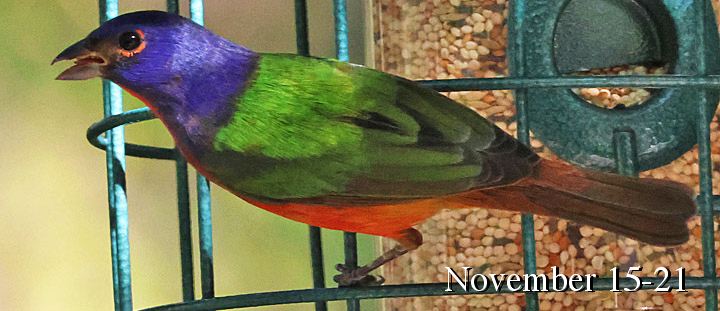

Monday, November 17: Flint Pen Strand
Our first guided bird walk of the season began at the Pinewoods parking lot and circled the white trail around the lakes and marsh. Because I was the sweep for the walk, I was armed with binoculars instead of a camera. So there are no photos from the walk.
We identified 42 species of birds. Outstanding sightings were a Ruby-throated Hummingbird high in the cypress along OBB road and a bright yellow Prairie Warbler just a little before that. Other warblers were Black-and-white, Palm, and Yellow-rumped. The female Northern Harrier made a brief appearance toward the end of the walk. Today she was foraging over the western section of the marsh rather than over the eastern half.
My yard
Monday was the only day available for a trail walk this week. Activities like a vet appointment for my cat Daisy, a doctor appointment for me, helping a neighbor, and trying to catch up on yard work occupied the rest of the week.
I did take breaks to watch wildlife in my yard. Visible birds in the yard away from the feeders were Downy, Pileated and Red-bellied Woodpeckers, Palm Warblers, Gray Catbirds, Northern Mockingbirds, a Great Blue Heron in the back yard by the canal, and the juvenile Red-shouldered Hawk.
Feeder birds included Painted Buntings, Tufted Titmice, Blue Jays, Mourning Doves, and more Red-bellied Woodpeckers. The buntings seemed to have settled in for the season. Three males and three females are visiting the feeders on a much more regular basis. The buntings don't like to share good spots and are frequently quibbling over the best areas. The two finch seed feeders are next to each other so several buntings can dine at the same time. Below are the two feeders at the same time onThursday afternoon.
The sunflower seed feeder hangs a short distance away where the Cardinals, who also don't like to share the feeder with others of their own species, a pair of Tufted Titmice, and Red-bellied Woodpeckers dine.
Trail cam animals have just been Cottontail Rabbits, Virginia Opossums, Southern Flying Squirrels, and one Raccoon. Five Virginia Opossums are regulars. They are wary but tolerate each other as long as they aren't at the same spot.
The possum population has doubled. One of the trail cameras in a more wooded part of the front yard and farther from the house captured the big female weighted down with five young opossums. The little ones have appeared on the camera by themselves, but when there's a free ride, why not take advantage of it?